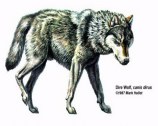 Wolves WolvesWolf History, Conservation, Ecology and Behavior
[www.wolfology.com]
|
The Dire Wolf
Jason Manning
Wolves, hyenas, cats, weasels, raccoons and ungulates (hooved mammals) all have a common ancestor -- primitive meat-eaters called creodonts which evolved about 100 million years ago. Descendants of the creodont, Carnivora -- distinguished by the development of carnassials (teeth used for tearing flesh) -- first appeared about 40 million years later. One variety of carnivore, Miacis, a tree-climber with retractable claws, diverged into two lines representing the canid and bear lineages. The former, Cynodictis, evolved into Cyriodesmus and Tomarctus, with the wolf and fox lineages traced to the latter. The wolf-like canid occurred in North America, probably during an interglacial period; it is postulated that the reemergence of glacial ice sheets across the continent separated the canids, with the gray wolf's ancestors being pushed north and then crossing the land bridge to Eurasia while the dire wolf's ancestors remained. The gray wolf developed in Eurasia and migrated to North America, probably in the Late Pleistocene, about a half-million years ago, to cohabit the continent with the coyote (Canis latrans) and the dire wolf (Canis dirus).
The dire wolf, which ranged from Mexico to the upper Mississippi Valley region and from the east coast to the west, proved a formidable competitor for the gray wolf. It had a more massive skull than the gray, with a jaw that was both thicker and longer. It had a generally more robust build, averaging 110 pounds (though it could top 200 pounds). As both species preyed on large herbivores, they could not readily coexist, and the gray wolf was relegated to the ice and tundra north of the dire's range. (Fossil evidence suggests that there may have been gray wolf-dire wolf interbreeding, but it was sporadic at best.) In contrast, the coyote was able to coexist with the dire wolf in the deciduous and boreal forests of the southern half of the continent; the coyote hunted small game and occupied an ecological niche distinct from that claimed by the dire.
When the last Ice Age ended 10,000 years ago the gray wolf began to expand southward, simultaneously with the dire wolf's rapid decline, which is blamed on dramatic postglacial climate changes responsible for the extinction of the Pleistocene megafauna (mammoth, mastodon, giant bison, etc.) upon which the dire preyed. The gray wolf proved far more adaptable. Able to travel farther and faster than the dire (which had smaller limbs relative to its body size), the gray could prey on the new smaller and more swift ungulates -- the moose, caribou, musk-ox and bison.
To survive in the severe environment of the continent's northern zone, the gray wolf established a very evolved social organization. The dire wolf, on the other hand, was not a social animal. It relied more on its physical attributes than on cooperative hunting; it did not require a sophisticated social organization to hunt in the stable and more temperate southern zone. Therefore, it may not have been motivated to temper its aggression toward members of its own species. Besides, evidence indicates that the dire had increasingly become a carrion-eater during the Late Pleistocene. Being a large, strong scavenger further mitigated against the dire wolf's development of a social organization that might have permitted it to work in tandem with other members of its species to successfully hunt the quick new ungulates. With its cooperative hunting skills honed in the crucible of the frozen north, the gray wolf soon became the apex predator in North America, while the dire wolf became extinct.
In 1854, Francis A. Linck found a fossilized jawbone in the Ohio River bed near present-day Evansville, Indiana. He sent it to Dr. Joseph Leidy in Philadelphia. Leidy decided the fossil -- the type specimen of the dire -- represented a new species of wolf. The remains of over 3,600 dire wolf individuals have been recovered from the La Brea tar pits in California -- more than any other species of mammal. In Texas, dire wolf fossil remains have been found in Briscoe and Bexar counties, near the communities of Midland and Lewisville, and at Friesenhahn Cave.
|
Copyright 2002 Jason Manning All Rights Reserved
Feel free to duplicate for educational purposes.
|
